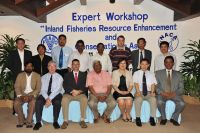Inland Fisheries Resource Enhancement and Conservation in China
7 February 2010 | Chen Daqing | 3326 views | .mp3 | 4.6 MB | China, Genetics and Biodiversity, Stock enhancement
Inland aquatic ecosystems in China have been largely influenced by the large-scale economic activities and over-exploitation of aquatic resources. Fisheries resource enhancement and conservation activities such as artificial fish nest, artificial fish releasing, forbidden fishing and establishment of natural reserves were carried out throughout China.
The purpose of these activities was to restore the quantity of inland fisheries resource, guarantee sustainable development of fishery, maintain biological diversity and preserve ecological balance. These activities with multiple ways, abundant species, large water areas and large scale practice have played an active role to resource enhancement and conservation. Through this practice, the ecological environment of inland waters improved, the biological diversity is raised, the fish catch is increased, and the social, ecological and economic benefits have been improved totally. However, several problems such as poor technology, nonstandard operation affected the fisheries resource enhancement and conservation and ecological stability.
This presentation reviews the history and practices and analyses the problems and insufficient in inland fisheries resource enhancement and conservation in China, and finally recommends some suggestions on technology and operation in order to sustain inland fisheries resources.
Creative Commons Attribution.
